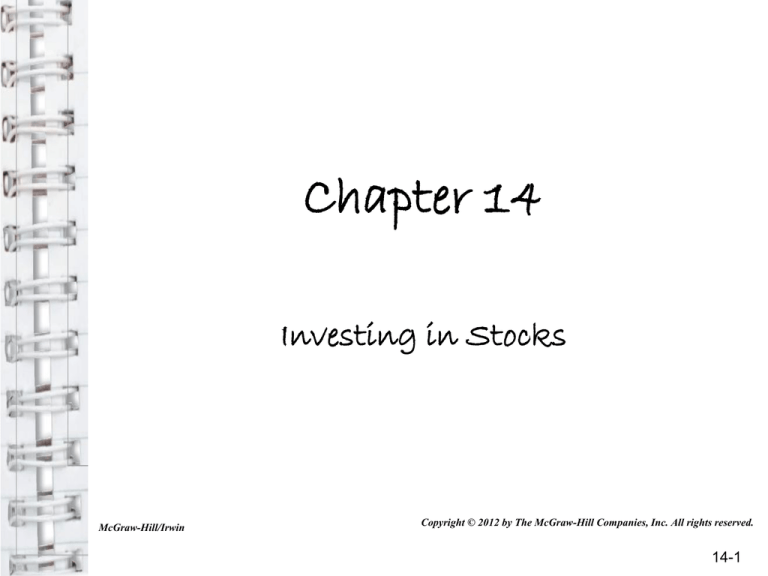
Chapter 14
Investing in Stocks
McGraw-Hill/Irwin
Copyright © 2012 by The McGraw-Hill Companies, Inc. All rights reserved.
14-1
14-2
Chapter 14
Learning Objectives
• Identify the most important features of
common and preferred stocks
• Explain how you can evaluate stock
investments
• Analyze the numerical measures that cause
a stock to increase or decrease in value
• Describe how stocks are bought and sold
• Explain the trading techniques used by longterm investors and short-term speculators
14-3
Common and Preferred Stocks
Objective 1: Identify the most important
features of common and preferred stocks
• Good investors know something about the company
before they invest in the company’s stock
• Gather information to evaluate a potential investment
in a stock
• Learn what the information you gather means
– Are sales increasing?
– Is net income increasing over time?
– Are earnings per share increasing over time?
• There are periods where stocks decline in value
• The key to success is to allow investments to work for
you over the long-term
14-4
Why Corporations Issue Common Stock
• To raise money for start-up costs and help pay for
expansion and their ongoing business activities
• They don’t have to repay the money a
stockholder pays for stock
• The investor can sell a share of stock to another
investor
14-5
Why Corporations Issue Common Stock
• Dividends are not mandatory. Most corporations
distribute 30-70% of their earnings to stockholders
• In return for investing in the company, stockholders
have voting rights
14-6
Why Investors Purchase Common
Stock
• They can make money in three ways
– Income from dividends in the form of cash or
additional stock
– Dollar appreciation of stock value
– Possible increased value from stock splits
• WHAT HAPPENS WHEN A CORPORATION SPLITS
ITS STOCK?
– A stock split happens when the shares owned by
existing stockholders are divided into a larger
number of shares
14-7
Preferred Stock
PREFERRED STOCK
• A “middle” investment and represents an
ownership position
• Investors in preferred stocks receive cash
dividends before common stock holders are paid
any cash dividends
• Investors that need a more predictable source of
income will chose preferred rather than common
stock
14-8
Preferred Stock (continued)
• You are an owner of the stock but have a known
rate of return. Shares are safer than common stock
because the dividends are more secure
• Cumulative Preferred stock
– Unpaid cash dividends accumulate and must be
paid before cash dividends are paid to the
common stock holders
• Convertible preferred stock
– Can be traded for shares of common stock in the
same company
14-9
Evaluating a Stock Issue
Objective 2: Explain how you can evaluate
stock investments
CLASSIFICATION OF STOCKS
Blue chip stock
Cyclical
Defensive
Growth
Income
Large cap
Mid cap
Small cap
Micro cap
Penny stock
14-10
Evaluating a Stock Issue
(continued)
THE INTERNET
• Most corporations have a Website, and the
information is useful in the following ways
– The Website is easily accessible
– More up to date information than the printed
material
– Websites like Yahoo and other search engines
can also be used to obtain information about
stock investments
– The Internet can also be used to access
professional advisory services like
• http://www.standardandpoors.com/
• http://www.valueline.com/
• http://www.morningstar.com/
14-11
Evaluating a Stock Issue (continued)
STOCK ADVISORY SERVICES
• Prepare printed materials that are more detailed
than information in newspapers
• Charge a fee
• Hundreds to choose from
– Standard and Poor’s reports
– Value Line
– Mergent’s Investor Service
– Morningstar
• As an investor, your job is to interpret the
information provided
14-12
Evaluating a Stock Issue (continued)
HOW TO READ THE FINANCIAL SECTION OF THE
NEWSPAPER
• Stock quotes are still available in most metropolitan
newspapers such and The Wall Street Journal
• Basic information is provided
– Name of company
– Stock symbol
– Price
14-13
Evaluating a Stock Issue (continued)
• Corporate News
•
The Federal government requires companies
to disclose information to the public.
• http://www.sec.gov/ is a website to access much of
the information
• Use of annual report
–
–
–
–
–
learn about the company
learn about management
learn about past performance
learn about goals
footnotes have important information
14-14
Numerical Measures That Influence
Investment Decisions
Objective 3: Analyze the numerical
measures that cause a stock to increase
or decrease in value
WHY CORPORATE EARNINGS ARE IMPORTANT
• Corporate earnings play a large part in the increase
or decrease in the price of a stock
• Earnings per share (EPS) are the corporation’s aftertax earnings divided by the number of outstanding
shares of a common stock. An increase in earnings
is generally a healthy sign
• Price-earnings (P/E) ratio
– Price of one share of stock divided by the earnings
per share of stock over the last 12 months
14-15
Numerical Measures That Influence
Investment Decisions (continued)
OTHER FACTORS THAT INFLUENCE THE
PRICE OF A STOCK
• Dividend payout = Annual dividend amount
EPS
• Dividend yield = Annual dividend amount
Price per share
14-16
Numerical Measures That Influence
Investment Decisions (continued)
OTHER FACTORS THAT INFLUENCE THE
PRICE OF A STOCK (continued)
• Total return = Dividends + Capital gain
• Annualized holding period yield =
Total return___ X 1
Original investment
N
N=Number of years investment is held
14-17
Numeric Measures That Influence
Investment Decisions (continued)
• Beta
– A measure of volatility compared to the S&P 500.
• Book value per share
Assets-Liabilities
Shares Outstanding
– If a share costs more than the book value the
company may be overextended or it may have a
lot of money in research and development
14-18
Numeric Measures That Influence
Investment Decisions (continued)
• Market to Book Ratio
Market value per share
Book value per share
– A low market to book may indicate an
undervalued stock
– A high market to book may indicate an
overvalued stock
14-19
Numeric Measures That Influence
Investment Decisions (continued)
INVESTMENT THEORIES
• Fundamental analysis
– Based on the assumption that a stock’s intrinsic
or real value is determined by the company’s
future earnings
– Fundamentalists consider the…
• Financial strength of the company
• Type of industry company is in
• New-product development
• Economic growth of the overall economy
14-20
Numeric Measures That Influence
Investment Decisions (continued)
• Technical analysis
– Based on the assumption that a stock’s value
is determined by the forces of supply and
demand in the stock market as a whole
– Not based on expected earnings or the
intrinsic value of a stock but rather on factors
found in the market as a whole
– Chartists plot past price movements and other
market averages to observe trends they use to
predict a stock’s future value
14-21
Numeric Measures That Influence
Investment Decisions (continued)
• Efficient market theory
– Based on the assumption that stock price
movements are purely random
– A stock’s current market price reflects its true
value
– It is impossible for an investor to outperform the
average for the stock market as a whole over a
period of time
14-22
Buying and Selling Stocks
Objective 4: Describe how stocks are
bought and sold
• Primary market
– A market in which an investor purchases financial
securities through an investment bank, or other
representative, from the issuer of those securities
– An investment bank is a financial firm that assists
corporations in raising funds, usually by helping to sell
new security issues
– An IPO occurs when a corporation sells stock to the
general public for the first time
• Secondary market
– A market for existing financial securities that are
currently traded among investors through brokers
14-23
Buying and Selling Stocks (continued)
SECURITY EXCHANGES
• A marketplace where member brokers who
represent investors meet to buy and sell securities
• The securities sold at an exchange must be listed,
or accepted for trading, at the exchange
• New York Stock Exchange, Regional Exchanges,
or Foreign Security Exchanges
14-24
Buying and Selling Stocks (continued)
SECURITY EXCHANGES (continued)
– Most OTC securities are traded over the
NASDAQ which is an electronic marketplace for
approximately 3,200 stocks
– Network of dealers who buy and sell the stocks of
companies not listed on a securities exchange
14-25
Buying and Selling Stocks (continued)
BROKERAGE FIRMS AND ACCOUNT EXECUTIVES
• An account executive, or stockbroker, is a licensed
individual who buys and sells securities for his or her
clients
• Financial objectives should be communicated to the
account executives, and the investor must be actively
involved in the investment decisions
14-26
Buying and Selling Stocks (continued)
BROKERAGE FIRMS AND ACCOUNT EXECUTIVES
(continued)
• Discount broker versus full service brokers
– How much advice do you want?
– Nearest office and toll-free phone number?
– Online and phone trading services and costs?
– Fees, charges and commissions?
14-27
Buying and Selling Stocks (continued)
STOCK TRANSACTIONS
• Market order: Request to buy or sell stock at the
current market value
• Limit order: Request to buy or sell a stock at a
specified price
• Stop order: Request to sell a stock at the next
available opportunity after its market price
reaches a specified amount
14-28
Long-Term and Short-Term
Investment Strategies
Objective 5: Explain the trading techniques used
by long-term investors and short-term
speculators
• Long-term techniques
– Buy and hold
– Dollar cost averaging
– Direct investment and dividend re-investment plans
(DRIPS)
14-29
Long-Term and Short-Term
Investment Strategies
Objective 5: Explain the trading techniques used
by long-term investors and short-term
speculators
• Short-term techniques
– Day trading
– Buying stock on margin (borrowing money)
– Selling short (borrowing stock)
– Trading in options (predetermined price)
14-30







